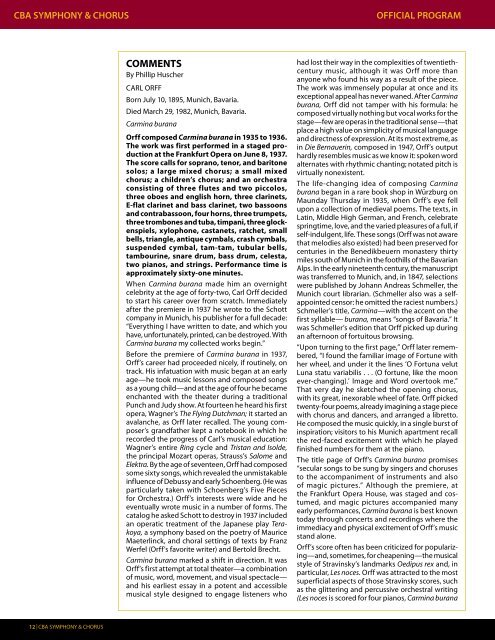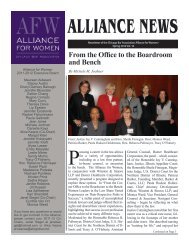CARMINA BURANA - The Chicago Bar Association
CARMINA BURANA - The Chicago Bar Association
CARMINA BURANA - The Chicago Bar Association
Create successful ePaper yourself
Turn your PDF publications into a flip-book with our unique Google optimized e-Paper software.
CBA SYMPHONY & CHORUS OFFICIAL PROGRAM<br />
12 | CBA SYMPHONY & CHORUS<br />
COmmEnTS<br />
By Phillip Huscher<br />
CARL ORFF<br />
Born July 10, 1895, Munich, Bavaria.<br />
Died March 29, 1982, Munich, Bavaria.<br />
Carmina burana<br />
Orff composed Carmina burana in 1935 to 1936.<br />
<strong>The</strong> work was first performed in a staged production<br />
at the Frankfurt Opera on June 8, 1937.<br />
<strong>The</strong> score calls for soprano, tenor, and baritone<br />
solos; a large mixed chorus; a small mixed<br />
chorus; a children’s chorus; and an orchestra<br />
consisting of three flutes and two piccolos,<br />
three oboes and english horn, three clarinets,<br />
E-flat clarinet and bass clarinet, two bassoons<br />
and contrabassoon, four horns, three trumpets,<br />
three trombones and tuba, timpani, three glockenspiels,<br />
xylophone, castanets, ratchet, small<br />
bells, triangle, antique cymbals, crash cymbals,<br />
suspended cymbal, tam-tam, tubular bells,<br />
tambourine, snare drum, bass drum, celesta,<br />
two pianos, and strings. Performance time is<br />
approximately sixty-one minutes.<br />
When Carmina burana made him an overnight<br />
celebrity at the age of forty-two, Carl Orff decided<br />
to start his career over from scratch. Immediately<br />
after the premiere in 1937 he wrote to the Schott<br />
company in Munich, his publisher for a full decade:<br />
“Everything I have written to date, and which you<br />
have, unfortunately, printed, can be destroyed. With<br />
Carmina burana my collected works begin.”<br />
Before the premiere of Carmina burana in 1937,<br />
Orff’s career had proceeded nicely, if routinely, on<br />
track. His infatuation with music began at an early<br />
age—he took music lessons and composed songs<br />
as a young child—and at the age of four he became<br />
enchanted with the theater during a traditional<br />
Punch and Judy show. At fourteen he heard his first<br />
opera, Wagner’s <strong>The</strong> Flying Dutchman; it started an<br />
avalanche, as Orff later recalled. <strong>The</strong> young composer’s<br />
grandfather kept a notebook in which he<br />
recorded the progress of Carl’s musical education:<br />
Wagner’s entire Ring cycle and Tristan and Isolde,<br />
the principal Mozart operas, Strauss’s Salome and<br />
Elektra. By the age of seventeen, Orff had composed<br />
some sixty songs, which revealed the unmistakable<br />
influence of Debussy and early Schoenberg. (He was<br />
particularly taken with Schoenberg’s Five Pieces<br />
for Orchestra.) Orff’s interests were wide and he<br />
eventually wrote music in a number of forms. <strong>The</strong><br />
catalog he asked Schott to destroy in 1937 included<br />
an operatic treatment of the Japanese play Terakoya,<br />
a symphony based on the poetry of Maurice<br />
Maeterlinck, and choral settings of texts by Franz<br />
Werfel (Orff’s favorite writer) and Bertold Brecht.<br />
Carmina burana marked a shift in direction. It was<br />
Orff’s first attempt at total theater—a combination<br />
of music, word, movement, and visual spectacle—<br />
and his earliest essay in a potent and accessible<br />
musical style designed to engage listeners who<br />
had lost their way in the complexities of twentiethcentury<br />
music, although it was Orff more than<br />
anyone who found his way as a result of the piece.<br />
<strong>The</strong> work was immensely popular at once and its<br />
exceptional appeal has never waned. After Carmina<br />
burana, Orff did not tamper with his formula: he<br />
composed virtually nothing but vocal works for the<br />
stage—few are operas in the traditional sense—that<br />
place a high value on simplicity of musical language<br />
and directness of expression. At its most extreme, as<br />
in Die Bernauerin, composed in 1947, Orff’s output<br />
hardly resembles music as we know it: spoken word<br />
alternates with rhythmic chanting; notated pitch is<br />
virtually nonexistent.<br />
<strong>The</strong> life-changing idea of composing Carmina<br />
burana began in a rare book shop in Würzburg on<br />
Maunday Thursday in 1935, when Orff’s eye fell<br />
upon a collection of medieval poems. <strong>The</strong> texts, in<br />
Latin, Middle High German, and French, celebrate<br />
springtime, love, and the varied pleasures of a full, if<br />
self-indulgent, life. <strong>The</strong>se songs (Orff was not aware<br />
that melodies also existed) had been preserved for<br />
centuries in the Benedikbeuern monastery thirty<br />
miles south of Munich in the foothills of the Bavarian<br />
Alps. In the early nineteenth century, the manuscript<br />
was transferred to Munich, and, in 1847, selections<br />
were published by Johann Andreas Schmeller, the<br />
Munich court librarian. (Schmeller also was a selfappointed<br />
censor: he omitted the raciest numbers.)<br />
Schmeller’s title, Carmina—with the accent on the<br />
first syllable— burana, means “songs of Bavaria.” It<br />
was Schmeller’s edition that Orff picked up during<br />
an afternoon of fortuitous browsing.<br />
“Upon turning to the first page,” Orff later remembered,<br />
“I found the familiar image of Fortune with<br />
her wheel, and under it the lines ‘O Fortuna velut<br />
Luna statu variabilis . . . (O fortune, like the moon<br />
ever-changing).’ Image and Word overtook me.”<br />
That very day he sketched the opening chorus,<br />
with its great, inexorable wheel of fate. Orff picked<br />
twenty-four poems, already imagining a stage piece<br />
with chorus and dancers, and arranged a libretto.<br />
He composed the music quickly, in a single burst of<br />
inspiration; visitors to his Munich apartment recall<br />
the red-faced excitement with which he played<br />
finished numbers for them at the piano.<br />
<strong>The</strong> title page of Orff’s Carmina burana promises<br />
“secular songs to be sung by singers and choruses<br />
to the accompaniment of instruments and also<br />
of magic pictures.” Although the premiere, at<br />
the Frankfurt Opera House, was staged and costumed,<br />
and magic pictures accompanied many<br />
early performances, Carmina burana is best known<br />
today through concerts and recordings where the<br />
immediacy and physical excitement of Orff’s music<br />
stand alone.<br />
Orff’s score often has been criticized for popularizing—and,<br />
sometimes, for cheapening—the musical<br />
style of Stravinsky’s landmarks Oedipus rex and, in<br />
particular, Les noces. Orff was attracted to the most<br />
superficial aspects of those Stravinsky scores, such<br />
as the glittering and percussive orchestral writing<br />
(Les noces is scored for four pianos, Carmina burana




